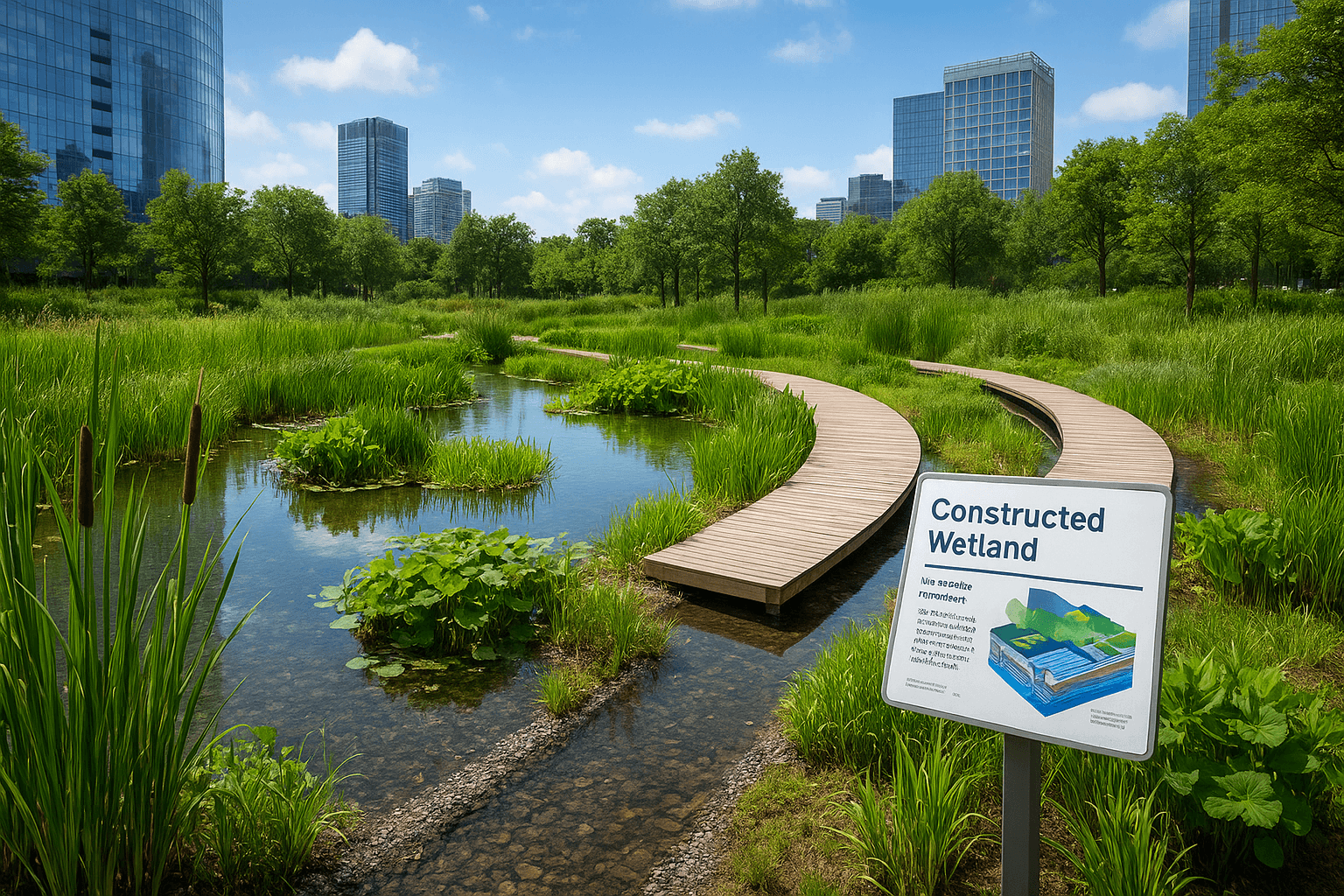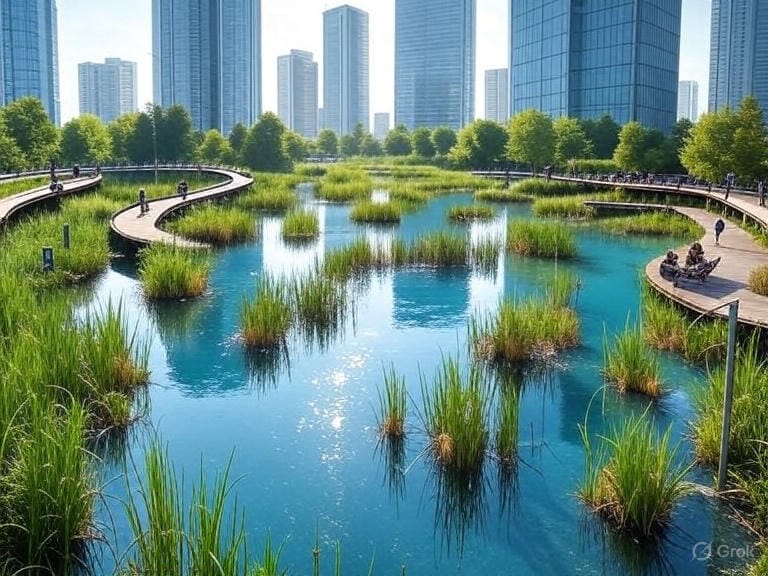
Table of Contents
ToggleThe role of Constructed wetlands for stormwater management
Rapid across the world has significantly altered natural drainage systems which has increased the risk of urban flooding. Impervious surfaces like roads, pavements and rooftop prevent water infiltration which causes stormwater runoff to accumulate quickly during heavy rainfall. Traditional drainage systems often fails to cope with this surge and leads to flash floods and infrastructure damage.
This is where constructed wetlands for stormwater management emerge as an innovative and nature based solution for managing flood risk. Constructed wetlands mimic the hydrological functions of natural wetlands but they are engineered to fit urban landscapes. The systems temporarily store access storm water by slowing down its flow and then gradually release them. This reduces pressure on conventional drainage networks. Additionally, their vegetation and soil layers facilitate natural filtration, removal of sediments and pollutants from stormwater before it enters water bodies.
This dual functionality makes constructed wetlands a sustainable alternative of grey infrastructure. Cities like Melbourne, Singapore, and New York have integrated constructed wetlands into their urban flood management plans. Their success highlights how these systems not only mitigate flood risks but also enhance urban biodiversity and aesthetic appeal which overall make cities more livable and climate resilient. Adopting such green infrastructure is no longer optional in a climate changing world.

How do constructed wetlands help in stormwater management
Constructed wetlands for stormwater management are critical in modern time as they are designed to replicate the hydrological and ecological functions of natural wetlands. Their primary role is to slow down and control runoff generated during heavy rainfall especially in highly urbanized areas where impermeable surfaces dominate. Traditional drainage systems quickly channel water away but constructed wetlands provide controlled storage and gradually release them. This process reduce peak discharge rates and minimizes the risk of flash floods.
The functionality of these systems relies on a combination of physical, chemical and biological processes. When stormwater enter into a constructed wetland, it first passes through a sedimentation zone where larger particles settle. Next the water flows under a series of vegetated zones where plant roots and microbial communities actively remove pollutants such as nitrogen, phosphorus and hydrocarbons. This natural filtration process enhances water quality and prevents contamination of rivers and groundwater resources.
Constructed wetlands can be classified into surface flow and sub surface flow systems. Surface flow wetlands maintain shallow water over vegetated soil which makes them visually appealing and biodiversity friendly. On the other hand, Subsurface flow wetlands move water through a gravel or soil medium beneath the surface which reduces the risk of mosquito breedings and odor issues.
Many cities across the world have integrated these wetlands into their urban stormwater infrastructure to meet sustainability goal and climate resilience standards. Beyond hydrological benefits, wetlands also support urban greening, improve microclimates and create recreational spaces to offer a multifunctional approach to urban design. For tier 1 cities constructed wetlands for stormwater management provide a scalable, low-maintenance, and eco-friendly solution.
What are the urban flood management strategies
1. Integrating Green infrastructure
Green infrastructure such as bioswales, green roof and permeable pavements helps to reduce surface runoff by increasing water infiltration. These systems mimic natural processes which allows rainwater to be absorbed and stored instead of flowing into storm drains. Many tier 1 cities have adopted green infrastructure as part of their climate resilience strategies to reduce pressure on drainage systems.
2. Constructed Wetlands for Stormwater Retention
Constructed wetlands act as natural water storage systems within urban areas. They temporarily store stormwater, reduce peak discharge rates and improve water quality through sedimentation and biological treatment. Cities like Melbourne and Singapore have successful integration of wetlands into urban landscapes which combines flood control with ecological benefits and aesthetic appeal. They are also helpful in stormwater treatment.
3. Smart Drainage and Early Warning Systems
Modern flood management now involves real time monitoring of rainfall and water levels using sensors and IoT- based technology. That gives a lot of benefits in constructed wetlands for stormwater management. Smart drainage system scan automatically control gates and pumps to regulate water flow during storms. Early warning alerts helps authorities and residence to be prepared in advance that overall helps in minimising flood damage.
4. Sustainable Urban Planning
Long term resilience depends on planning cities with climate adaptation in mind. This includes zoning policies that prevent construction in flood prone areas and creation of retention basins. Cities’ plans also include reserving open green spaces for water absorption. Big cities can reduce their vulnerability to extreme rainfall events and ensure continuity of essential services during floods By just prioritizing sustainable urban design.

Green Infrastructure for Flood Control
What is green infrastructure
Green infrastructure refers to a network of natural and semi natural systems that are designed to manage water sustainabily. Unlike traditional grey infrastructure such as concrete drains and pipelines, green infrastructure uses vegetation, soil and natural processes to observe and filter stormwater. It’s core principal is resilience which allow cities to handle extreme rainfall with improved environmental quality.
Key Components of Green Infrastructure
- Green roofs: an infrastructure in which vegetation layers are present on rooftop that absorb rainwater and reduce runoff and also helps in lower urban heat island effects.
- Permeable Pavements: permeable payments are those surfaces that allow water to seep through it so that surface flooding could be reduced and groundwater could be replenished.
- Rain Gardens and Bioswales: they are those landscape areas that capture and infiltrate rainwater to remove pollutants and ease the burden on drainage systems.
These components collectively reduce runoff volume, day peak flow and enhance water quality which makes them vital for flood control.
Benefits beyond flood control
Green infrastructure delivers multiple co-benefits beyond hydrology. It improves air quality, reduce temperatures in urban heat Islands and enhances biodiversity by creating habitats for plants and wildlife. These features means a better aesthetics, improved mental well being and increased property value – all these co benefits make green infrastructures both an environmental and economic investment.
Global Adoption Trends
Big cities like New York, Copenhagen, and Singapore have implemented large scale green infrastructure projects to combat urban flooding and climate change. New York’s green infrastructure plan focuses on green roofs and rain gardens, on the other side Copenhagen integrates permeable streets with retention basins for stormwater storage. These examples and many others highlight how green infrastructure transforms cities into climate-resilient ecosystems.

Stormwater control using constructed wetlands: Global practices
Melbourne, Australia – Urban Wetland Integration
Melbourne is a global leader in terms of co-operating constructed wetlands into city planning. Its Water Sensitive Urban Design (WSUD) strategy integrates wetlands into residential and commercial zones which captures stormwater and improve water quality before it is discharged into rivers. The design emphasizes aesthetics, biodiversity, and recreational value that turns flood control infrastructure into community assets.
Singapore – ABC Waters Program
Singapore’s Active, Beautiful and Clean Waters (ABC) program promotes green-blue infrastructure In which constructed wetlands play a major role in managing intense tropical rains. These wetlands are combined with canals and reservoirs to regulate runoff, supply treated water and prevent flash floods. These approaches reduces flood risks and ensures water security in a densely urbanized nation. For more detailed guidence refer to the EPA’s constructed wetlands page.
United States – EPA-Recommended Wetland Systems
In United States, the Environmental Protection Agency (EPA) is responsible for constructed wetlands for stormwater management to meet water quality regulations. States like Oregon and Florida use surface-flow wetlands in urban and agricultural settings to control peak runoff and filter pollutants. These systems are often paired with smart monitoring technologies for performance optimization.
Europe – Multi-Functional Wetland Networks
European cities such as Copenhagen and Rotterdam integrate wetlands into sponge city frameworks that are designed to absorb excess rainfall and store it for later use. These constructed wetlands for stormwater management function with green roofs, permeable pavements and retention basins to form a comprehensive flood resilient systems.
Key design principles for success
Constructed wetlands are adapted to local hydrology. Wetland’s size and vegetation should match rainfall pattern and runoff volumes. Wetlands should be perfectly integrated with urban drainage systems for efficient flow management. It should include monitoring system. Real time sensors improve operational efficiency and complaints and compliance with regulations.
FAQs
How effective are constructed wetlands for stormwater management?
Constructed wetlands are highly effective for storm water management because they slow runoff, reduce peak discharge and naturally filter pollutants like nitrogen and phosphorus. They also support biodiversity and improve urban aesthetics which makes them a sustainable alternative to traditional drainage systems.
What are the best urban flood management strategies for Tier 1 cities?
The best urban flood management strategies includes integration of green infrastructure, installation of constructed wetlands, implementation of permeable pavement and uses of smart drainage systems with real time monitoring. These approaches promote climate resilience in major metropolitan areas with reducing flood risk.
Why is green infrastructure important for flood control in modern cities?
Green infrastructure is crucial for flood control because it reduces stormwater runoff, prevents flash floods and improves water quality. Features like rain gardens, green roofs, and constructed wetlands manage excess rainfall naturally and helps cities to adapt climate change.
